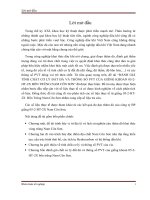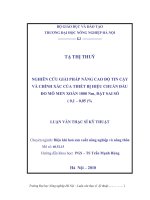05 NTM
Bạn đang xem bản rút gọn của tài liệu. Xem và tải ngay bản đầy đủ của tài liệu tại đây (225.74 KB, 59 trang )
SOUTH EAST ASIA
TRADE POLICY
TRAINING NETWORK
SEATRANET ADVANCED COURSE
NON AGRICULTURAL MARKET ACCESS
(NAMA)
Module 5:
Non-Tariff Measures
1
SOUTH EAST ASIA
TRADE POLICY
TRAINING NETWORK
Outline of Module 5
1. Non Tariff Measures
2. The Technical Barriers to Trade
Agreement
3. The SPS Agreement
4. The Customs Valuation Agreement
5. The Pre-shipment Inspection Agreement
6. The Agreement on Import Licensing
7. NTM agreements and WTO Negotiations
2
SOUTH EAST ASIA
TRADE POLICY
TRAINING NETWORK
1. Non Tariff Measures
3
SOUTH EAST ASIA
TRADE POLICY
TRAINING NETWORK
What are Non Tariff Measures?
•Any measures other than tariffs, which restrict or
distort international trade are NTMs
•Many NTMs are in place for legitimate reasons
such as safety, security, health, public morals etc.
• Many are applied under Article XX providing for
general exceptions. But they must not be applied as
a means of unreasonable or unjustifiable
discrimination or as disguised restriction on trade.
4
SOUTH EAST ASIA
TRADE POLICY
TRAINING NETWORK
•The Uruguay Round included the negotiation
of NTMs in its mandate initially through
notification.
- Bring measures into negotiation
- Strengthen governing rules
- Develop surveillance mechanisms
-Improve dispute settlement procedure
5
SOUTH EAST ASIA
TRADE POLICY
TRAINING NETWORK
Agreements related to
NTMs
• Five Agreements were
negotiated in the Uruguay
Round which are an integral
part of the WTO Agreement
–
–
–
–
–
Technical Barriers to Trade
Sanitary and Phytosanitary
Custom Valuation
Preshipment Inspection
Import Licensing
6
SOUTH EAST ASIA
TRADE POLICY
TRAINING NETWORK
2. The Technical Barriers
to Trade Agreement
7
SOUTH EAST ASIA
TRADE POLICY
TRAINING NETWORK
Technical Barriers to
Trade Agreement
•The TBT strengthened and clarified the original
plurilateral TBT Agreement negotiated during the
Tokyo Round
•It covers the use of technical regulations and
standards to regulate the entry of traded goods.
8
SOUTH EAST ASIA
TRADE POLICY
TRAINING NETWORK
Technical Barriers to
Trade Agreement
•Conformity assessment means the technical
procedures such as testing, verification, inspection
and certification, undertaken to confirm that
products fulfill regulations and standards
•Generally exporters pay the cost of conformity
assessment.
9
SOUTH EAST ASIA
TRADE POLICY
TRAINING NETWORK
Technical Barriers to
Trade Agreement
• Legitimate objectives of
regulations and standards:
–
–
–
–
•
Protection of human safety or health
Protection of animal and plant life or health
Protection of the environment
Prevention of deceptive practices
Other objectives could include
trade facilitation, quality
regulations and regulations aimed
at harmonizing certain sectors.
10
Technical Barriers to
Trade Agreement
•The TBT recognizes the legitimate need to
have regulations and standards and provides
considerable flexibility:
“no country should be prevented from taking
SOUTH EAST ASIA
TRADE POLICY
TRAINING NETWORK
measures necessary to ensure the quality of
its exports, or the protection of human,
animal, and plant life or health, of
environment, or for the prevention of deceptive
practices, at the levels it considers
appropriate.”
11
SOUTH EAST ASIA
TRADE POLICY
TRAINING NETWORK
Technical Barriers to
Trade Agreement
•Flexibility is limited by the requirements that
technical regulations “are not prepared,
adopted or applied with a view to, or with the
effect of creating unnecessary obstacles to
trade.”
12
SOUTH EAST ASIA
TRADE POLICY
TRAINING NETWORK
The Principles of the TBT
• The principles of the TBT
include:
–
Avoidance of unnecessary obstacles to trade
–
Non-discrimination and national treatment
–
Harmonization
–
Equivalence of technical regulations
–
–
Mutual recognition of conformity
procedures
assessment
Transparency
13
SOUTH EAST ASIA
TRADE POLICY
TRAINING NETWORK
Special and Differential
Treatment
• Special provision for developing
countries:
–
Eases impact of provisions whose full application is
not consistent with developing countries’
development, financial and trade needs.
– May adopt regulations and standards aimed at
preserving existing technologies and production
methods.
–
May request support from international
standardizing bodies.
14
SOUTH EAST ASIA
TRADE POLICY
SPECIAL AND
TRAINING NETWORK
DIFFERENTIAL TREATMENT
Disputes will be settled using the WTO
dispute settlement system.
15
SOUTH EAST ASIA
TRADE POLICY
TRAINING NETWORK
3. The SPS Agreement
Agreement on the Application of
Sanitary and Phytosanitary
Measures
16
SOUTH EAST ASIA
TRADE POLICY
TRAINING NETWORK
Definitions
• Sanitary measures relate to human and
animal health.
• Phytosanitary measures deal with plant
life and its protection.
17
SOUTH EAST ASIA
TRADE POLICY
TRAINING NETWORK
The SPS Agreement
• Application is limited:
– Protection of human or animal life or health from
risks arising from additives, contaminants, toxins or
disease-causing organisms in their food
– Protection of human life from plant- or animal– carried diseases
– Protection of animal or plant life from the
introduction of pests, diseases or disease-causing
organisms
– Protection of a country from damage caused by the
entry, establishment or spread of pests
18
SOUTH EAST ASIA
TRADE POLICY
TRAINING NETWORK
The SPS Agreement
•Negotiated during the UR in parallel with the
major agricultural negotiations
• Response to fear that the agriculture-related tariff
and non tariff measure reductions would be
circumvented by disguised protectionist measures.
19
SOUTH EAST ASIA
TRADE POLICY
TRAINING NETWORK
Coverage
•Not limited to agricultural products, but also
includes forest and fish products
• Much more specific and in-depth coverage for
broader range of health protection and trade
measures than the original TBT provided
20
SOUTH EAST ASIA
TRADE POLICY
TRAINING NETWORK
Clarity and Transparency
The SPS reduces the possible arbitrariness of
governments’ SPS decisions and regulations by
clarifying the factors that should be taken into
account when imposing such measures.
21
SOUTH EAST ASIA
TRADE POLICY
TRAINING NETWORK
Scientific Basis for Decisions
Based on International standards
or guidelines as produced by:
• Codex Alimentarius Commission
(FAO/WHO), [for human health]
• The World Organization for Animal Health
• International Plant Protection
Convention
• Any other designated by the WTO
22
SOUTH EAST ASIA
TRADE POLICY
TRAINING NETWORK
SPS Characteristics
• Regulations must be based on scientific
principles and risk assessment.
• Risk assessment may lead to treating
countries differently.
• Unlike TBT, SPS regulations may be
based on production process methods.
23
SOUTH EAST ASIA
TRADE POLICY
TRAINING NETWORK
SPS Characteristics
Other features of the SPS include:
•
•
•
•
•
Harmonization
Equivalence
Disease free areas
Transparency
Special measures for developing countries
24
SOUTH EAST ASIA
TRADE POLICY
TRAINING NETWORK
SPS Characteristics
•Dispute settlement is subject to the WTO
system.
• However, some international standards
setting bodies have their own non-binding
dispute settlement systems through which
differences may be settled.
25









